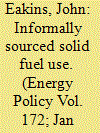|
|
|
Sort Order |
|
|
|
Items / Page
|
|
|
|
|
|
|
| Srl | Item |
| 1 |
ID:
116737


|
|
|
|
|
| Publication |
2012.
|
| Summary/Abstract |
It is well known that poor rural households in low-income economies are reliant on traditional fuels to meet basic domestic energy needs, but little is known about the specific underlying socio-economic drivers of residential fuel choices in Ethiopia. I used the linear approximation almost ideal demand system (LAAIDS) with normalized prices to compute expenditure elasticity and a multinomial logit model (MLM) to examine household fuel use. The LAAIDS model result showed that expenditure was elastic for modern fuels, but inelastic for traditional fuels. Regression results from the MLM indicated that fuel choice behaviour of rural households could be more accurately described as 'fuel stacking' behaviour as opposed to the 'energy ladder' hypothesis. In rural areas household fuel choice may be constrained by limited access to commercial fuels and efficient cook stoves, supply dependency and affordability, consumer preferences and a web of other intricate factors. Rural households had less incentive for fuel switching due to underlying factors and the availability of fuel wood without direct financial cost. With continued deforestation and receding forests, households are expected to develop inter fuel substitution and switching behaviour conditional on access to modern energy technologies.
|
|
|
|
|
|
|
|
|
|
|
|
|
|
|
|
| 2 |
ID:
176870


|
|
|
|
|
| Summary/Abstract |
The success of time-of-use (TOU) pricing, where consumers are charged higher rates during peak usage windows, depends on consumer flexibility—an assumption that may not be true for all households or activities. We draw on concepts from social practice theory to explore the flexibility of residential electricity consumption, examining both household rules that govern energy conservation and activities that comprise the peak demand period. Surveying 337 households in a Northern California city slated for TOU rates, our goal was to better understand household energy rules and peak activities; willingness-to-shift peak activities; and relationships between household rules, willingness-to-shift and electricity usage. While respondent demographics and estimated monthly electricity bill (our proxy for usage) were associated with following energy rules, motivations for following rules (e.g., environmental, monetary) dominated. For respondents’ willingness-to-shift peak activities, square footage, number of household members, and smart technology were important, along with energy rule participation and the number of peak activities. Energy rule participation was also associated with lower bills, while number of household members and peak activities were associated with higher bills. Our findings provide insights into pathways for modifying energy use during peak to allow for easier integration of renewables into the grid.
|
|
|
|
|
|
|
|
|
|
|
|
|
|
|
|
| 3 |
ID:
188561


|
|
|
|
|
| Summary/Abstract |
Developing effective policy solutions to transition away from the use of solid fuels for residential heating purposes can be hindered by the lack of reliable data on its use. One such issue is the extent of informal solid fuel use, that is, consumption from sources outside of formal commercial channels. This is an area which has been largely ignored in previous empirical research. Using a survey of residential solid fuel users, the extent of solid fuel use in the residential sector in Ireland from informal sources for two fuels, sod peat and wood, is quantified. Sod peat is found to be almost exclusively sourced informally while just over half of wood use is estimated to be sourced by households in this way. Factors including location, household income, being a primary user of the fuel and having strong cost motivations all effect the probability of sourcing solid fuels informally relative to formal sources. The sizeable extent to which informal sources of solid fuels are used in Ireland arising from the analysis in this paper, highlights the potential for substitution to this unregulated alternative. This should be carefully monitored for effective implementation of new and existing solid fuel regulations.
|
|
|
|
|
|
|
|
|
|
|
|
|
|
|
|
| 4 |
ID:
181763


|
|
|
|
|
| Summary/Abstract |
Buildings in the EU are responsible for 40% of energy use, with approximately 75% of buildings classed as energy inefficient. Many energy efficiency technologies have failed to deliver on the promised savings. This paper measures the extent to which residential dwelling retrofit delivers real energy savings in Ireland using a unique dataset of whole-home energy use (n = 8,572 households) over a two-year period. It is one of the largest studies of retrofit using whole-home energy data for a general housing sample, who do not disproportionately experience fuel poverty. It uses whole-home energy data to capture potential fuel switching induced by retrofit. Finally, this study addresses concerns regarding self-selection issues associated with the decision to undergo a retrofit by comparing with a second control group of homes that received a retrofit prior to the observation period.
|
|
|
|
|
|
|
|
|
|
|
|
|
|
|
|
|
|
|
|
|